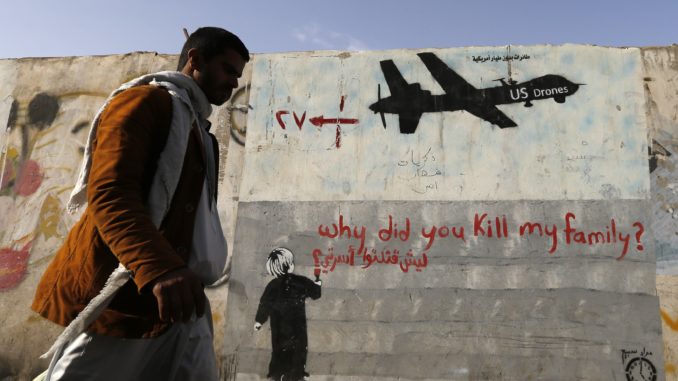
Source: The New Internationalist
Not long ago, Somalia’s sky was associated with life and hope; it was a source of rain that enabled people to farm in order to feed their families, they would raise their hands and look to the sky when seeking help from God and at night the stars were used as a navigation system.
Today, for those living under constant US drone strikes, the clear blue sky brings death and destruction; moving clouds are seen as a hiding place for drone predators and at night, every star becomes a potential killer.
‘Life became unbearable especially at night,’ said Halimo Ali, a drone refugee, who now lives at Uunlaye Camp for Internally Displaced Persons (IDPs) in the outskirts of Mogadishu. ‘You don’t know who is killing you.’
In recent months, thousands of people reportedly escaping drone attacks have arrived in the Somali capital. Halimo, a mother of six, from Qumbarer Village, some 80 kilometres from Mogadishu, had few goats to milk and a donkey track used as transport.
A simple farmer, she is not into the politics of the ‘war on terror’ but all she knew was that staying at her village was not safe. ‘The [drone] noise was nonstop. You often hear so-and-so village has been bombed. The other night, in a nearby village, the bombs killed three men who were watering their farm. There are many more cases.’
Drone-imposed curfew was in place at night. In the past, as there’s no electricity, using a torch in the evening or burning a wood to scare off hyenas was a way of life. But that is now deemed too risky; they fear the lights will attract the predatory machine.
Last year, there were 34 US drone and airstrikes killing more than 200 people, according to the Bureau of Investigative Journalism.
This figure, which is compiled from open sources including the US Africa Command, is likely to be too low. Obtaining the exact number of civilian deaths is almost impossible because the affected areas are under Al-Shabaab-control. The group won’t let independent journalists and human rights groups to investigate the impact of the drone campaign.
Nevertheless, since Donald Trump was elected, the campaign has intensified. Weeks after taking office, he signed a directive declaring parts of Somalia ‘an area of active hostility’. Technically, the presidential decree was permission for US personnel to press the kill-button without much consideration for civilian lives.
The US claims that its drone assault is surgically precise and an effective tool to defeat the militants. It has had some success in eliminating some of Al-Shabaab’s top commanders including their late leader Ahmed Abdi Godane in 2014 and his predecessor Aden Hashi Ayrow in 2008. But every Al-Shabaab fighter that’s killed, there are thousands of young men willing to fill his shoes. And every US target that is ‘missed’, there are many innocent lives that are lost.
At Uunlaye camp, where most of the residents are drone refugees, they feel they were on America’s hit list.
‘If they were targeting armed men, why kill people who were watering their farm?’ asked Halimo. ‘Why kill people who were resting under trees? Why kill people who were sleeping in their homes? There were no [Al-Shabaab] fighters in our village.’
Abdinur Hussein, 82-years-old grandfather, who also sought sanctuary in the overcrowded IDP Camp outside Mogadishu, agrees. A lifetime farmer, he has lived through Somalia’s long and bloody civil war. But it is the killer in the sky, he cannot see, that forced him, his wife and their seven children out of their home – for the first time in their life.
‘We fled our home because of the invisible planes that were bombing us day and night,’ said Abdinur, while hiding in his makeshift tent – not from drones – but from the scorching sun. ‘We don’t know who’s behind the attacks but what we know is that there are planes that drop bombs on us. The bombing is indiscriminate.’
These Somali farmers, who can barely point out America on a map, are innocent yet they are victims of the US ‘war on terror’. Beyond the figures and numbers exist communities terrorized by the Pentagon’s killing machine. Any sound they hear, they think it will be the last; the buzz of the bee, the humming of a car engine in the distance, and even the mosquito whine which they grew up with.
They are emotionally traumatized, forced out of their homes and, in the process, they have lost their dignity. Today, they are begging Mogadishu residents for food; the same people they used to supply their farm produce in exchange for cash.
Less productivity among the farming community means the local economy will be affected badly. Especially, the drone hit area is the breadbasket of Somalia – a nation recovering from a 30-year-long conflict.
Over the past 10 years, Al-Shabaab fighters have shown how adaptable and resilient they are. Forces from several African nations supported by the west have been fighting against the militant group and they haven’t defeated them – far from it. Drone strikes won’t bring about the downfall of Al-Shabaab either. In fact, it’s more likely to strengthen them.
In the past three decades, Somalis have experienced death and destruction on an unimaginable scale, the last thing we need is more wars to prolong their suffering.
And surely, in simple terms, the US, supposedly the leader of the free world and the most powerful nation on earth – could let Somalis have the freedom to live.
Jamal Osman is a multi-award winning Somali journalist and filmmaker based in London. He has covered the African continent extensively for Channel 4 News and also contributes to other international media outlets.
